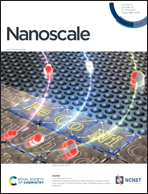Optogenetics-inspired manipulation of synaptic memory using all-optically controlled memristors†
Abstract
Memristive synapses compatible with optogenetic techniques allow for the fast and low-power manipulation of memory activities using light in artificial neural systems. However, most of the optoelectronic memristors operate in the hybrid optic–electric mode; the reversible regulation of memristive states solely using light for optogenetic emulation is difficult. In this work, an all-optical controlled optoelectronic memristor (Au/Cs2AgBiBr6/Au) is developed for mimicking optogenetics-tuned memory formation and erasing behaviors in biological synapses. We show that the memristor exhibits positive and negative persistent photoconductivity effects under different light wavelengths, attributed to light-regulated carrier de-trapping/trapping at the Au/Cs2AgBiBr6 interface. This device can emulate both excitatory and inhibitory synaptic plasticity and associated learning and memory effects under light illumination. We constructed a prototype optoelectronic synaptic array and implemented the all-optically controlled memory implantation, erasing, and modification, demonstrating the light-reconfigured cognition capabilities. Our findings will inspire the development of all-optically controlled artificial neural systems with good reconfigurability for efficient neuromorphic computing and machine vision.



 Please wait while we load your content...
Please wait while we load your content...